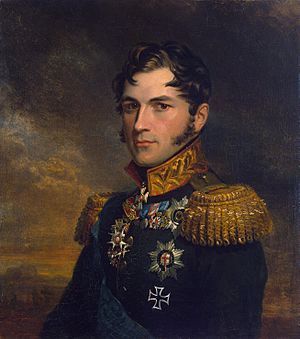Succession to the Belgian throne facts for kids

The Belgian throne has a special order for who gets to be the next king or queen. This order is called the line of succession. There are currently sixteen people in this line. When a new king or queen takes over, they must first take an important oath, as explained in the Belgian constitution.
Contents
Who Can Be King or Queen?
Since 1991, Belgium uses a rule called absolute primogeniture for the family of King Albert II. This means that the oldest child, whether a boy or a girl, is next in line. Before 1991, the rule was different; only boys could inherit the throne. This old rule was called agnatic primogeniture.
Today, only descendants of King Albert II can become king or queen. This means the old rule about only boys inheriting doesn't really apply to anyone anymore.
Rules for Marriage
If a person in the line of succession wants to get married, they need permission from the king or queen. If they marry without this permission, they lose their right to the throne. But, they can get it back if the king or queen agrees, and if the Parliament also agrees.
What if there are no more eligible people from King Leopold I's family? The current king or queen can choose someone to be the next in line, but the Parliament must agree. If no one is chosen, the throne would become empty. If the throne is empty, the Parliament would choose a Regent (someone to rule temporarily). Then, new elections would happen, and the new Parliament would choose the next king or queen.
Special Cases in the Line of Succession
When Princess Astrid married in 1984, the old rule (only boys could inherit) was still in place. So, she didn't need permission because she wasn't in line for the throne. But when the rule changed in 1991 to include girls, it was decided that she had received the needed permission. This allowed her and her children to be in the line of succession.
In 2014, Prince Amedeo got married. It was first reported that he didn't ask his uncle, King Philippe, for permission. This would have meant he lost his right to the throne. However, in 2015, a special royal decision was made. It said that permission had been given for his marriage, even after it happened.
In 2020, a court decided that Delphine Boël is the daughter of King Albert II. She was given the title of Princess. However, because she was born outside of marriage, she cannot be in the line of succession. Even if she could, she was born after her three half-siblings, so she would be after them in line anyway.
No Other Heads of State
Someone who is already the leader of another country cannot become the King or Queen of the Belgians. Both parts of the Belgian Parliament would have to agree to this, with a large number of members present and a two-thirds vote in favor.
How a New King or Queen Takes the Throne
When a king or queen dies, both parts of the Belgian Parliament meet within ten days. Until the new king or queen takes their oath, the government ministers take care of the king's duties.
The new king or queen only officially becomes the monarch after taking a special oath. They say: "I swear to observe the Constitution and the laws of the Belgian people, to maintain national independence and territorial integrity." They say this in front of both parts of Parliament.
What if the King Can't Rule?
If the king or queen cannot rule (for example, due to illness), or if the next in line is too young, the Parliament chooses a Regent. A Regent is someone who rules temporarily. This Regent also takes the same oath. There can only be one Regent at a time.
This is different from many other countries where the next person in line automatically becomes monarch right away. In Belgium, there's a short time between one monarch leaving the throne (usually by death, but twice by stepping down) and the next one taking the oath.
Current List of Succession
 King Albert II (born 1934)
King Albert II (born 1934)
 King Philippe (born 1960)
King Philippe (born 1960)
- (1) Princess Elisabeth, Duchess of Brabant (b. 2001)
- (2) Prince Gabriel (b. 2003)
- (3) Prince Emmanuel (b. 2005)
- (4) Princess Eléonore (b. 2008)
- (5) Princess Astrid, Archduchess of Austria-Este (b. 1962)
- (6) Prince Amedeo, Archduke of Austria-Este (b. 1986)
- (7) Archduchess Anna Astrid of Austria-Este (b. 2016)
- (8) Archduke Maximilian of Austria-Este (b. 2019)
- (9) Princess Maria Laura, Archduchess of Austria-Este (b. 1988)
- (10) Prince Joachim, Archduchess of Austria-Este (b. 1991)
- (11) Princess Luisa Maria, Archduchess of Austria-Este (b. 1995)
- (12) Princess Laetitia Maria, Archduchess of Austria-Este (b. 2003)
- (6) Prince Amedeo, Archduke of Austria-Este (b. 1986)
- (13) Prince Laurent (b. 1963)
- (14) Princess Louise (b. 2004)
- (15) Prince Nicolas (b. 2005)
- (16) Prince Aymeric (b. 2005)
See also
 In Spanish: Sucesión al trono de Bélgica para niños
In Spanish: Sucesión al trono de Bélgica para niños

